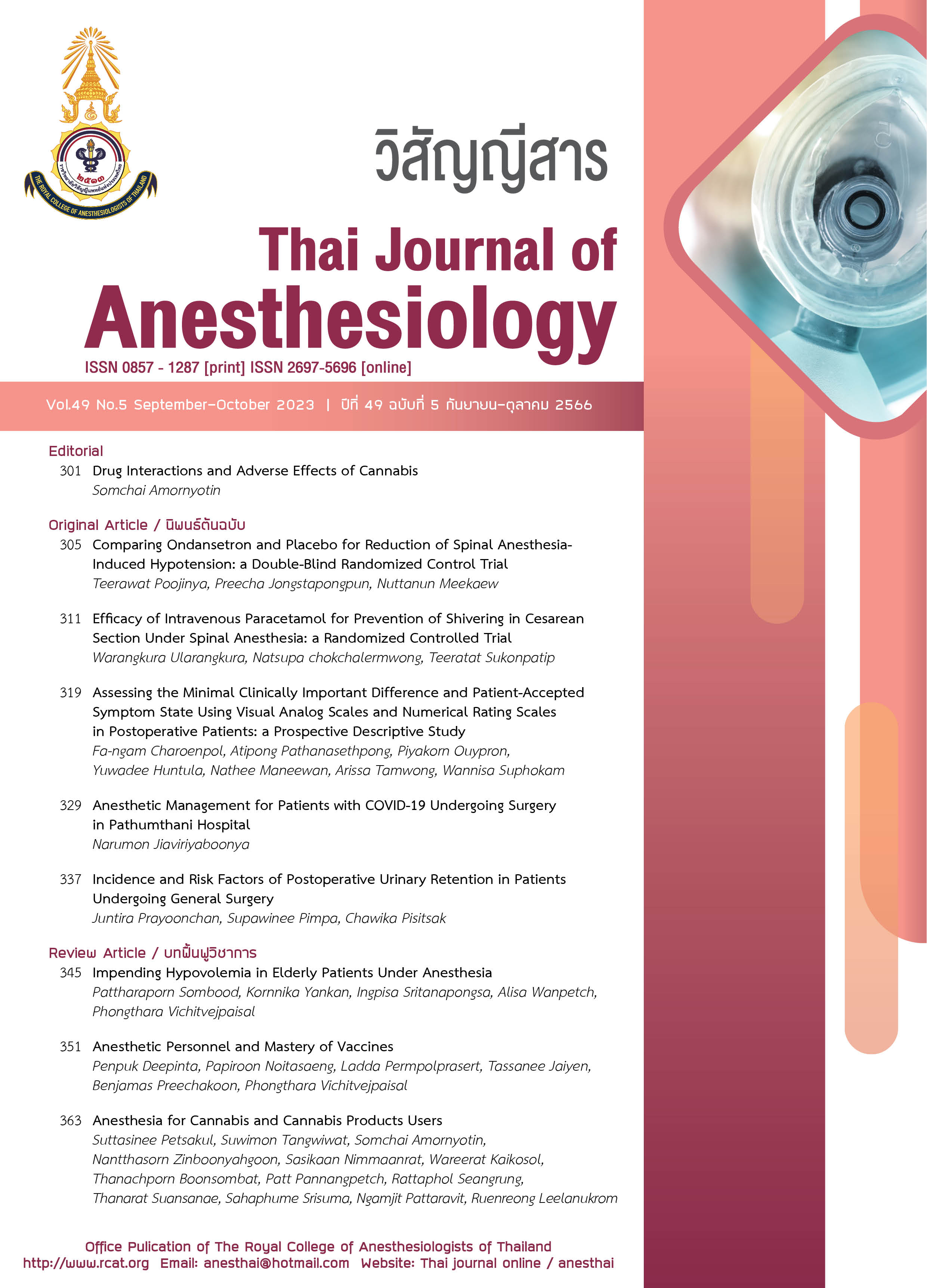Incidence and Risk Factors of Postoperative Urinary Retention in Patients Undergoing General Surgery
Main Article Content
Abstract
Background: Postoperative urinary retention is a common complication for patients undergoing general surgery with either general or regional anesthesia. Postoperative urinary retention refers to an inability to urinate normally after surgery, even with a strong urge to do so. This may result in straining to urinate for an extended period, causing discomfort and stress for the patient. The incidence of postoperative urinary retention varies from 5% to 70% depending on patient characteristics and the type of surgery. Methods: This retrospective observational study enrolled patients who underwent general surgery at Ramathibodi Hospital between January 1, 2017 and December 31, 2021 by systematic random sampling is a random sampling when the population has similar characteristics. But the characteristics of the population are already arranged in numerical order. Randomization can therefore be done systematically. By dividing the number of populations, the number of samples was required. The medical records were reviewed and the diagnosis of postoperative urinary retention were based on the history of urinary catheterization from urinary bladder distention within 24 hours postoperatively. Results: The total of patients in this study were 430 cases. Postoperative urinary retention was diagnosed in 125 cases (29.1%). Independent risk factors of postoperative urinary retention were spinal anesthesia compared to general anesthesia (adjusted odds ratio (AOR) 2.942 (1.667-5.19); P<0.001), intraoperative use of ephedrine (AOR 2.598 (1.563-4.318); P<0.001), postoperative use of intravenous morphine (AOR 2.457 (1.079-5.592); P=0.032), male gender (AOR 2.233 (1.296-3.848); P=0.004) and history of hypertension (AOR 2.123 (1.108-4.067); P=0.023). Conclusion: Incidence of postoperative urinary retention was still high. Risk factors were spinal anesthesia, intraoperative use of ephedrine, postoperative use of intravenous morphine, male gender and hypertension.
Article Details

This work is licensed under a Creative Commons Attribution-NonCommercial-NoDerivatives 4.0 International License.
References
Billet M, Windsor TA. Urinary retention. Emerg Med Clin North Am. 2019;37:649-60.
ดุษฎี อรรจน์อังกูร, พัชรี โพธิ์สนธ์, พรหมประทาน พงศ์อธิโมกข์, พิสิฏฐ์ เลิศวานิช, บุศรา ศิริวันสาณฑ์. ปัจจัยที่มีผลต่อภาวะปัสสาวะคั่งในผู้ป่วยที่เข้ารับการผ่าตัดเอ็นไขว้หน้าข้อเข่า. วิสัญญีสาร. 2564;47:310-5.
ธนพร นันต์ธนพานิช. อุบัติการณ์การเกิดภาวะปัสสาวะคั่งหลังผ่าตัดและระยะเวลาที่ผู้ป่วยสามารถปัสสาวะได้เองภายหลังการฉีดยาชาเข้าช่องน้ำไขสันหลังในการผ่าตัดไส้เลื่อนและริดสีดวงทวารในโรงพยาบาลยโสธร. วารสารโรงพยาบาลมหาสารคาม. 2563;17:94-103.
Zaheer S, Reilly WT, Pemberton JH, Ilstrup D. Urinary retention after operations for benign anorectal diseases. Dis Colon Rectum. 1998;41:696-704.
Agrawal K, Majhi S, Garg R. Post-operative urinary retention: review of literature. World J Anesthesiol. 2019;8:1-12.
Baldini G, Bagry H, Aprikian A, Carli F. Postoperative urinary retention: anesthetic and perioperative considerations. Anesthesiology. 2009;110:1139-57.
Hollman F, Wolterbeek N, Veen R. Risk factors for postoperative urinary retention in men undergoing total hip arthroplasty. Orthopedics. 2015;38:e507-11.
Cha YH, Lee YK, Won SH, Park JW, Ha YC, Koo KH. Urinary retention after total joint arthroplasty of hip and knee: systematic review. J Orthop Surg (Hong Kong). 2020;28:2309499020905134.
นิภาพันธ์ สาสิงห์, วราภรณ์ เชื้ออินทร์, ทิพยวรรณ มุกนำพร, กาญจนา อุปปัญ, สมยงค์ ศรีชัยปัญหา. สำรวจภาวะปัสสาวะคั่งหลังผ่าตัดในผู้ป่วยที่ได้รับการระงับความรู้สึกด้วยเทคนิค spinal หรือ epidural block ชนิดฉีดครั้งเดียวในโรงพยาบาลศรีนครินทร์. in Srinagarind Hospital. ศรีนครินทร์เวชสาร. 2551;23:311-6.
นิพพาภัทร์ สินทรัพย์, จิณวัตร จันครา, บุปผา ใจมั่น. โรคความดันโลหิตสูงในผู้สูงอายุ: เพชฌฆาตเงียบที่ควรตระหนัก. วารสารวิทยาลัยพยาบาลพระปกเกล้า จันทบุรี. 2560;28:100-11.
Scholten R, Kremers K, van de Groes SAW, Somford DM, Koëter S. Incidence and risk factors of postoperative urinary retention and bladder catheterization in patients undergoing fast-track total joint arthroplasty: a prospective observational study on 371 patients. J Arthroplasty. 2018;33:1546-51.
กิตติยา วิจิตรมาลา, สุชาดา ป้องขวาเลา, กฤษณา พิมพลีชัย. การเปรียบเทียบประสิทธิผลการให้ยาอีเฟดรีนรูปแบบฉีดเข้าหลอดเลือดดำร่วมกับการให้สารน้ำกับการให้สารน้ำอย่างเดียวในการป้องกันการเกิดภาวะความดันโลหิตต่ำจากการให้ยาชาทางช่องน้ำไขสันหลังในหญิงตั้งครรภ์ที่เข้ารับการผ่าตัดคลอดแบบนัดหมาย. วารสารโรงพยาบาลมหาสารคาม. 2563;17:33-44.
Ringdal M, Borg B, Hellström AL. A survey on incidence and factors that may influence first post-operative urination. Urol Nurs. 2003;23:341-6, 354.
Bjerregaard LS, Bogø S, Raaschou S, et al. Incidence of and risk factors for postoperative urinary retention in fast-track hip and knee arthroplasty. Acta Orthop. 2015;86:183-8.
Luger TJ, Garoscio I, Rehder P, Oberladstätter J, Voelckel W. Management of temporary urinary retention after arthroscopic knee surgery in low-dose spinal anesthesia: development of a simple algorithm. Arch Orthop Trauma Surg. 2008;128:607-12.


